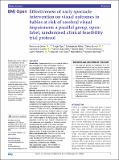Effectiveness of early spectacle intervention on visual outcomes in babies at risk of cerebral visual impairment : a parallel group, open-label, randomised clinical feasibility trial protocol
Abstract
Introduction Hypoaccommodation is common in children born prematurely and those with hypoxic ischaemic encephalopathy (HIE), with the potential to affect wider learning. These children are also at risk of longer-term cerebral visual impairment. It is also well recognised that early intervention for childhood visual pathology is essential, because neuroplasticity progressively diminishes during early life. This study aims to establish the feasibility and acceptability of conducting a randomised controlled trial to test the effectiveness of early near vision correction with spectacles in infancy, for babies, at risk of visual dysfunction. Methods and analysis This is a parallel group, open-label, randomised controlled (feasibility) study to assess visual outcomes in children with perinatal brain injury when prescribed near vision spectacles compared with the current standard care—waiting until a problem is detected. The study hypothesis is that accommodation, and possibly other aspects of vision, may be improved by intervening earlier with near vision glasses. Eligible infants (n=75, with either HIE or <29 weeks preterm) will be recruited and randomised to one of three arms, group A (no spectacles) and two intervention groups: B1 or B2. Infants in both intervention groups will be offered glasses with +3.00 DS added to the full cycloplegic refraction and prescribed for full time wear. Group B1 will get their first visit assessment and intervention at 8 weeks corrected gestational age (B1) and B2 at 16 weeks corrected gestational age. All infants will receive a complete visual and neurodevelopmental assessment at baseline and a follow-up visit at 3 and 6 months after the first visit. Ethics and dissemination The South-Central Oxford C Research Ethics Committee has approved the study. Members of the PPI committee will give advice on dissemination of results through peer-reviewed publications, conferences and societies. Trial registration number ISRCTN14646770, NCT05048550, NIHR ref: PB-PG-0418-20006.
Citation
Bullaj , R , Dyet , L , Mitra , S , Bunce , C , Clarke , C S , Saunders , K , Dale , N , Horwood , A , Williams , C , St Clair Tracy , H , Marlow , N & Bowman , R 2022 , ' Effectiveness of early spectacle intervention on visual outcomes in babies at risk of cerebral visual impairment : a parallel group, open-label, randomised clinical feasibility trial protocol ' , BMJ Open , vol. 12 , no. 9 , e059946 . https://doi.org/10.1136/bmjopen-2021-059946
Publication
BMJ Open
Status
Peer reviewed
ISSN
2044-6055Type
Journal article
Description
Funding information: This work was supported by the NIHR Central Commissioning Facility (grant number PB-PG-0418-20006/Grant name -NIHR RfPB). CB’s post is part funded by the NIHR BRC at the Royal Marsden NHS Foundation Trust and the Institute of Cancer Research London.Collections
Items in the St Andrews Research Repository are protected by copyright, with all rights reserved, unless otherwise indicated.

